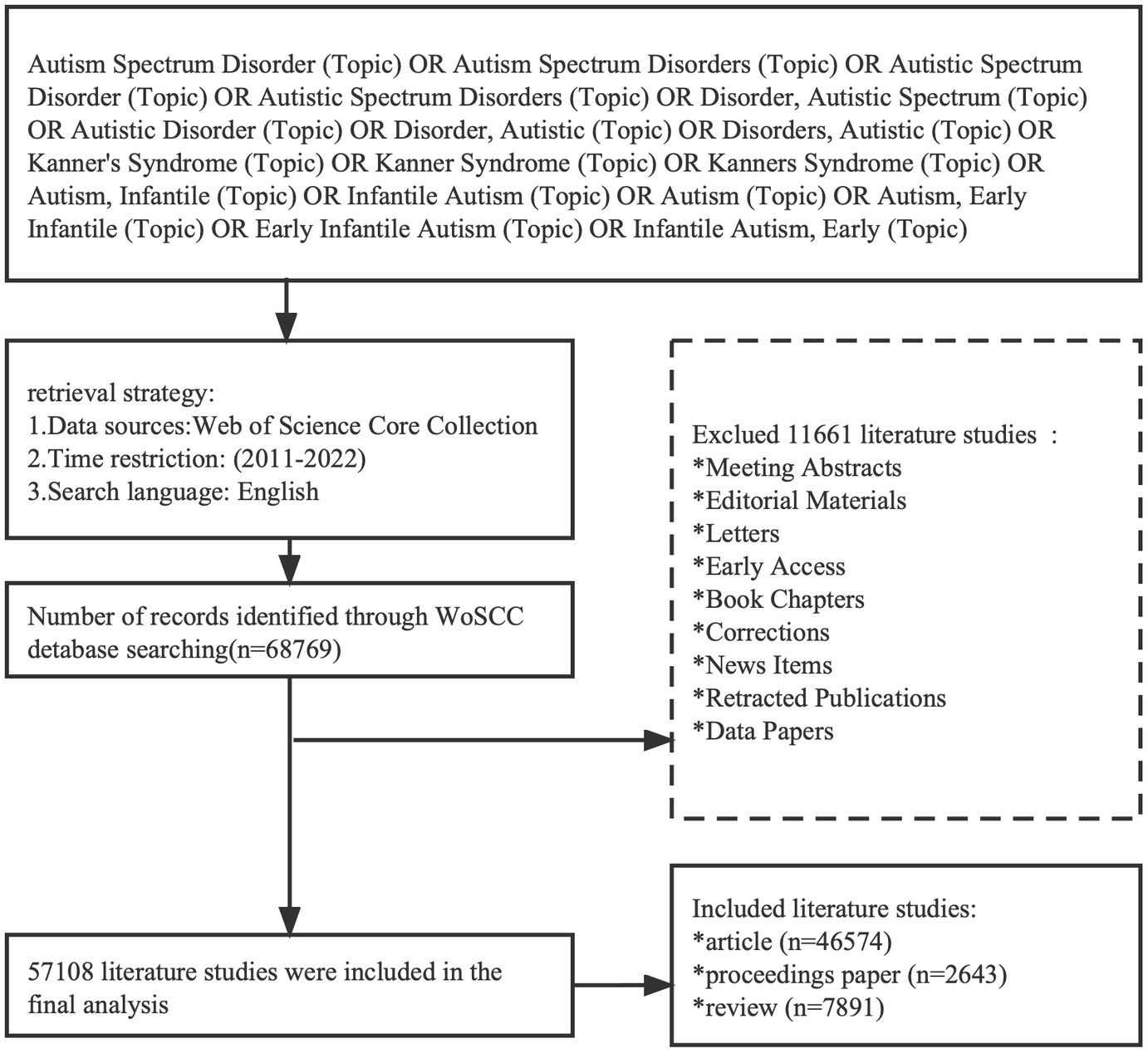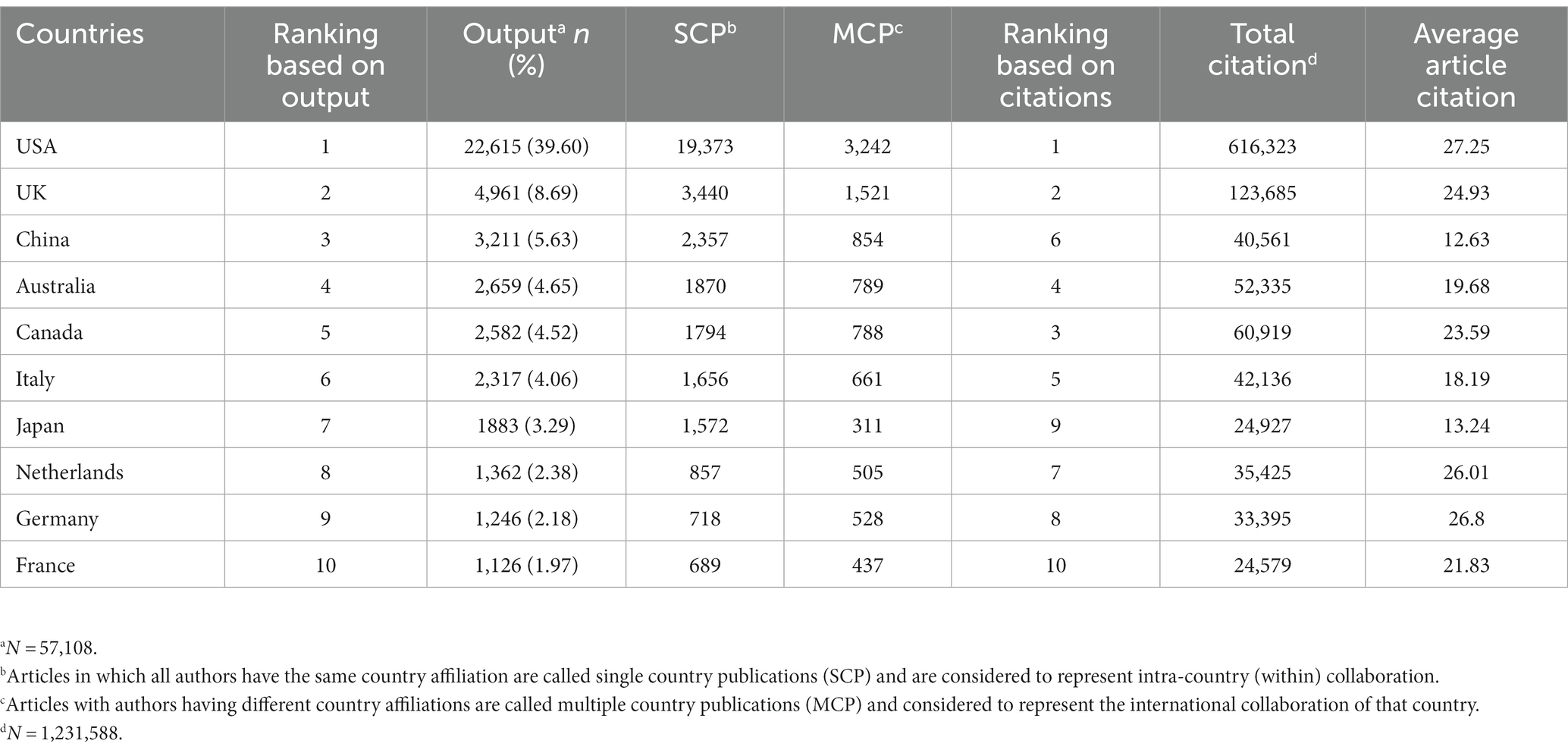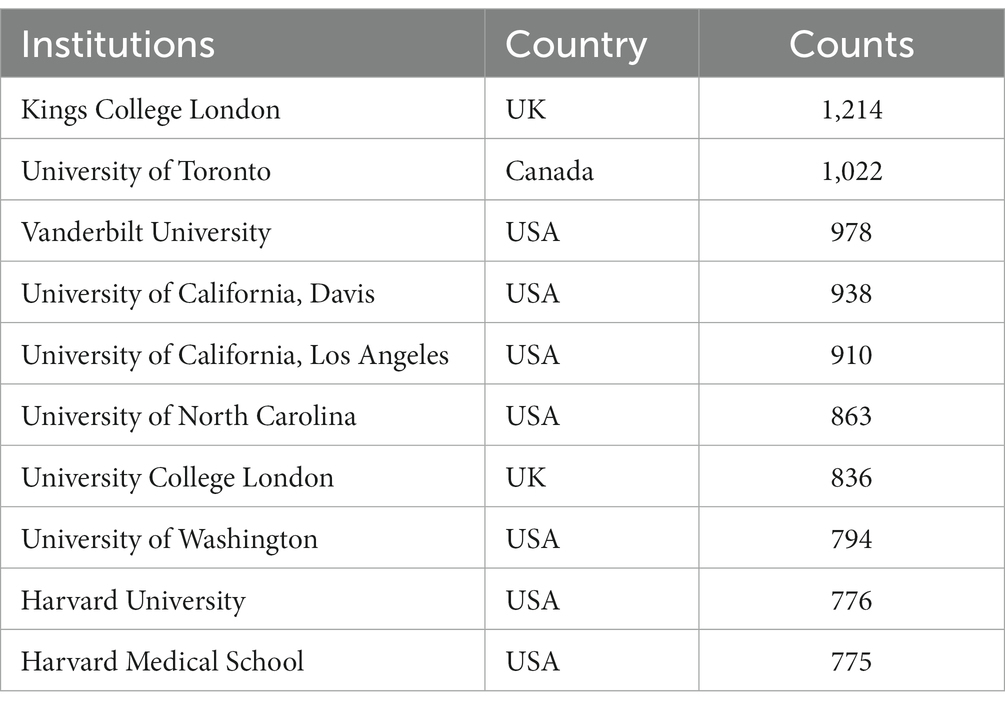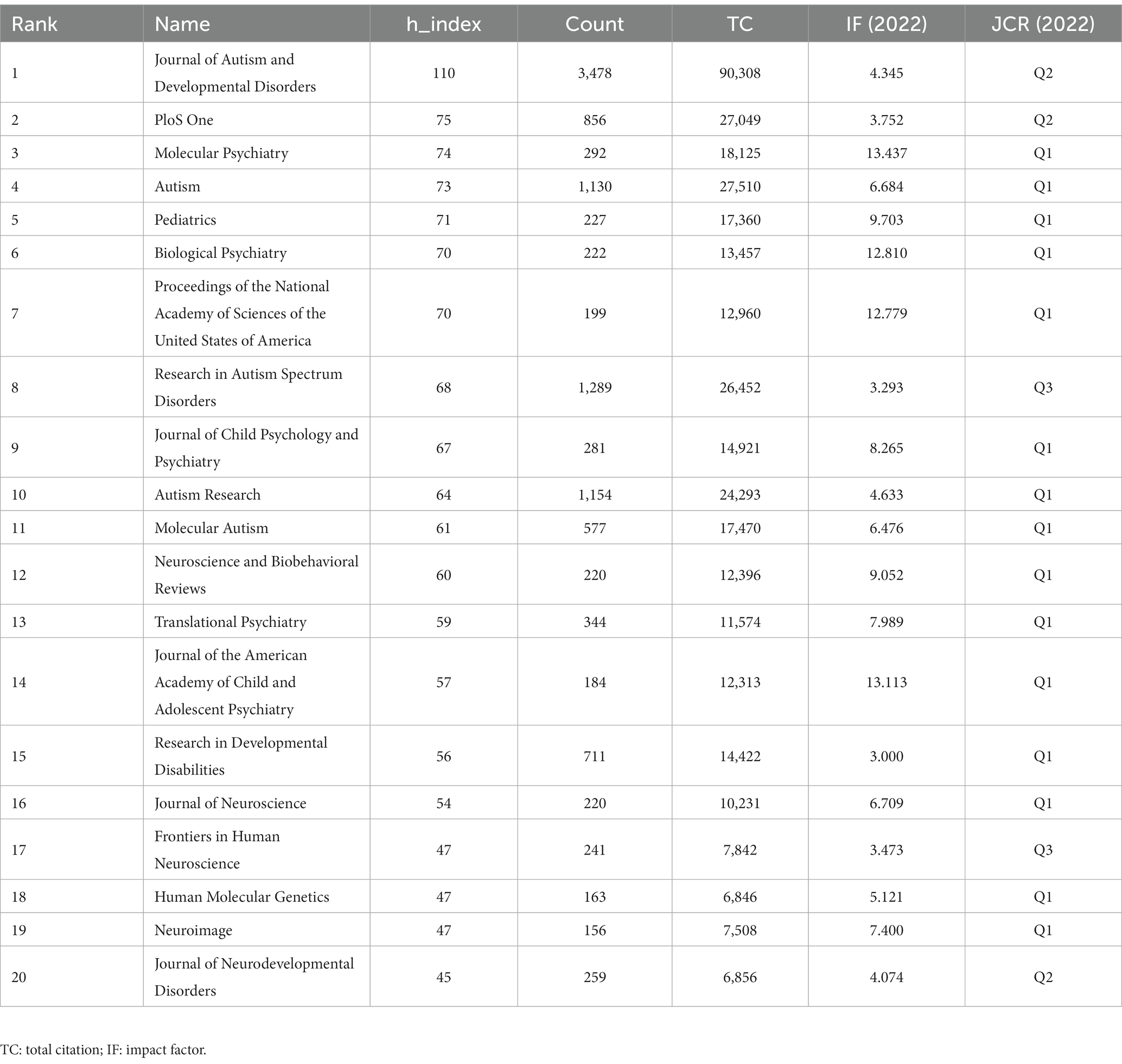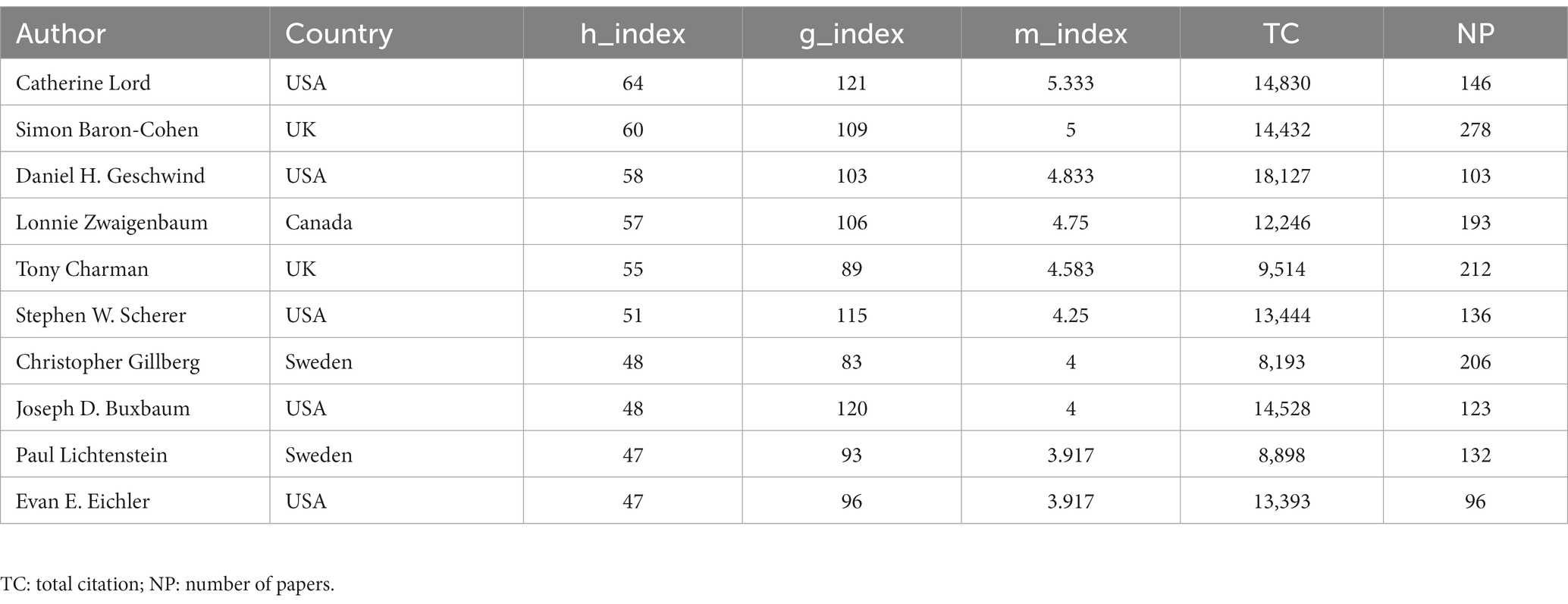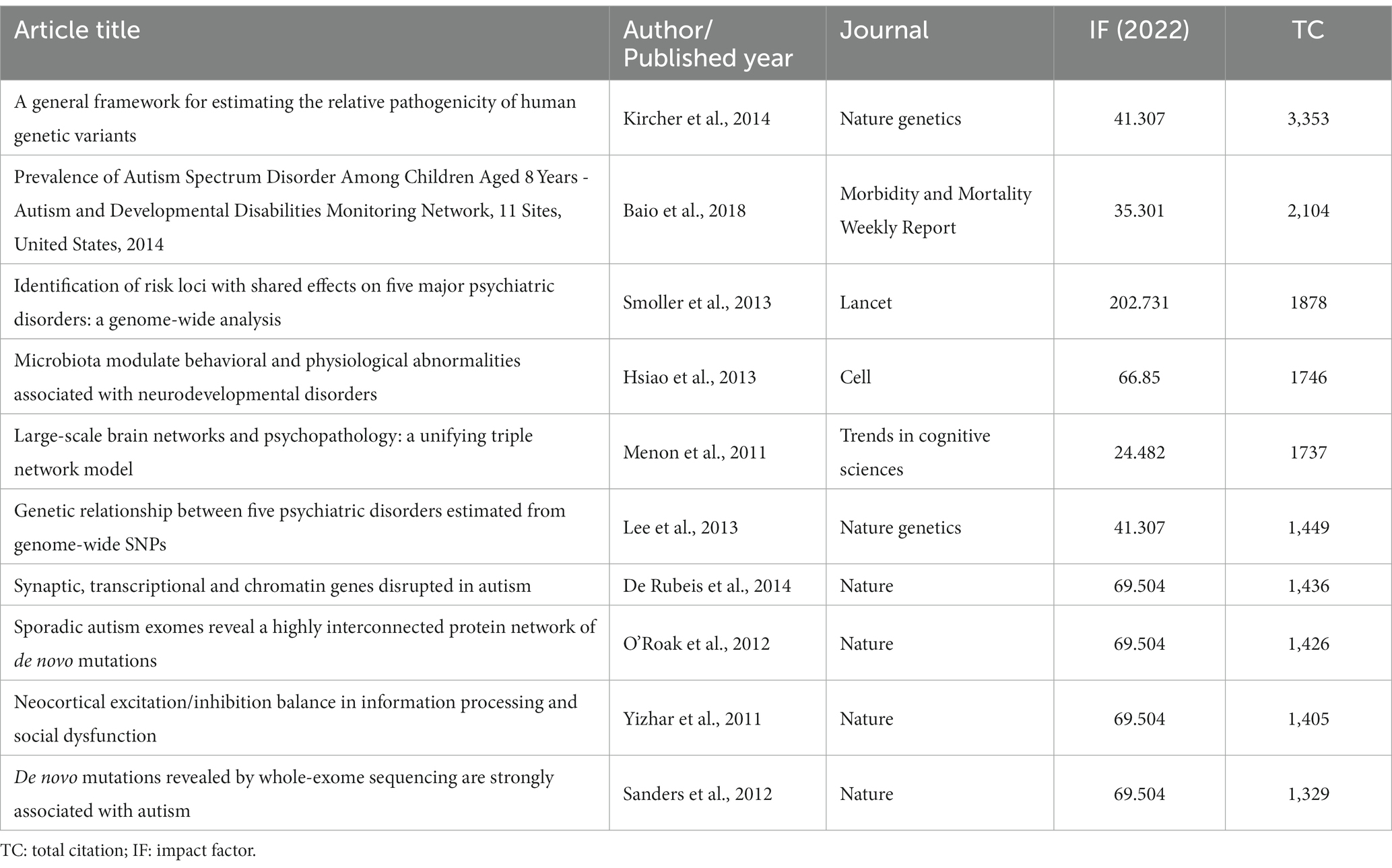- 1National Clinical Research Center for Mental Disorders (Peking University Sixth Hospital), NHC Key Laboratory of Mental Health (Peking University), Peking University Sixth Hospital, Peking University Institute of Mental Health, Beijing, China
- 2Translational Medicine Center of Chinese Institute for Brain Research, Beijing, China
- 3Guangdong Key Laboratory of Mental Health and Cognitive Science, Institute for Brain Research and Rehabilitation (IBRR), South China Normal University, Guangzhou, China
Background: In recent years, a large number of studies have focused on autism spectrum disorder (ASD). The present study used bibliometric analysis to describe the state of ASD research over the past decade and identify its trends and research fronts.
Methods: Studies on ASD published from 2011 to 2022 were obtained from the Web of Science Core Collection (WoSCC). Bibliometrix, CiteSpace, and VOSviewer were used for bibliometric analysis.
Results: A total of 57,108 studies were included in the systematic search, and articles were published in more than 6,000 journals. The number of publications increased by 181.7% (2,623 in 2011 and 7,390 in 2021). The articles in the field of genetics are widely cited in immunology, clinical research, and psychological research. Keywords co-occurrence analysis revealed that “causative mechanisms,” “clinical features,” and “intervention features” were the three main clusters of ASD research. Over the past decade, genetic variants associated with ASD have gained increasing attention, and immune dysbiosis and gut microbiota are the new development frontiers after 2015.
Conclusion: This study uses a bibliometric approach to visualize and quantitatively describe autism research over the last decade. Neuroscience, genetics, brain imaging studies, and gut microbiome studies improve our understanding of autism. In addition, the microbe-gut-brain axis may be an exciting research direction for ASD in the future. Therefore, through visual analysis of autism literature, this paper shows the development process, research hotspots, and cutting-edge trends in this field to provide theoretical reference for the development of autism in the future.
Introduction
Autism spectrum disorder (ASD) refers to a group of early-onset, lifelong, heterogeneous neurodevelopmental conditions with complex mechanisms of emergence (1). The prevalence of ASD has increased from 1 in 69 by 2012 to 1 in 44 by 2018, as reported by the Centers for Disease Control and Prevention for 2012–2018 (2, 3). Recent research estimates the male-to-female ratio is closer to 2:1 or 3:1, indicating a higher diagnostic prevalence of autism in males compared to females (4–6). Some studies have shown a high heritability of 80–93% in ASD and reported hundreds of risk gene loci (7).
Specific autistic characteristics usually appear before the age of 3 years, and some children on the spectrum may have limited nonverbal and verbal communication by the age of 18–24 months (8, 9). The diagnosis of ASD is based on the core features of social communication impairment and unusual and repetitive sensory-motor behavior (10). Some autistic individuals can be definitively diagnosed with autism as early as 2–3 years of age and the mean age of diagnosis for autistic children is still 4–5 years (1, 11). It is important to stress that more adults are getting assessed for possible autism (5). As autism is increasingly diagnosed, multidisciplinary involvement can help have a positive impact on the well-being and quality of life for both children and adults on the spectrum (12). Several mental diseases also affect autistic individuals, increasing the diagnosis complexity (13).
Over the past decade, researchers have struggled to explain the neurological etiology, and great progress has been made in the genetics, epigenetics, neuropathology, and neuroimaging of ASD (9). However, there is a lack of systematic review of field research and discussion of future research hotspots. Bibliometrics (14) belongs to interdisciplinary research, which has been widely used in science by analyzing highly cited papers, field keyword clustering, and the internal cooperation links of countries, thus providing a comprehensive interpretation of the development process of autism research field (15).
In some of the previous bibliometrics studies on ASD, a single software was used to focus on a specific field or research aspect of the autism (16–18), and the trend in the past decade has not yet been displayed. The present study comprehensively combines Bibliometrix package, CiteSpace, and VOSviewer to (1) dynamically assess quantitative indicators of ASD research publications and use different index indicators to measure the quality of research; (2) further identify the most contributing countries, institutions, journals, and authors; (3) analyze the citation network architecture; (4) determine the top 100 most cited papers; (5) conduct keyword analysis. Subsequently, bibliometrics was used to understand the current hotspots and trends in the field of ASD research for further in-depth investigation.
Materials and methods
Data collection and search strategies
We comprehensively searched the Web of Science Core Collection (WoSCC) database from 2011 to 2022. WoSCC is a daily updated database covering an abstract index of multidisciplinary literature that exports complete citation data, maintained by Thomson Reuters (New York, NY, USA) (19). The articles’ data were independently searched by two researchers on May 29, 2022, to avoid bias caused by database updates. The scientometric retrieval process is illustrated in Figure 1. A total of 68,769 original articles in English language were retrieved, excluding 11,661 irrelevant articles, such as meeting abstracts, editorial materials, corrections, and letters. A total of 57,108 documents were exported, and the retrieved documents would be exported in the form of all records and references.
Grey prediction model
Grey models (GM) are used to construct differential prediction models with limited and incomplete data (20). The GM (1,1) model, with high accuracy and convenient calculations, is extensively utilized in the energy and medical industries (21). We used the standard GM (1,1) model to forecast the annual publication volume over the next 5 years. The operation of GM (1,1) model was done by using Python software.
Bibliometric analysis and visualization
The records of the retrieved publications were exported to Bibliometrix, CiteSpace, and VOSviewer for further bibliometric analysis.
Bibliometrix package (running on R4.0.3) was utilized to capture and extract the bibliographic information on selected publications, including topic, author, keywords, and country distribution (22). The productivity of authors/journals in the field was measured by the number of publications (Np) and assessing metrics, such as the number of citations, publication h-index value, and m-index value. The h-index is used to quantify the scientific output and measure the citation impact, and two people with similar h-index may have a similar impact in the scientific field, even if the total number of papers or total citations are different (23). The m-index can be used to compare the influence of scholars with different academic career years. The number of citations of a document is a measure of its scientific impact to a certain extent (24). Bibliometrix package was also used to screen the top 100 articles and explore research trends and hotspots.
VOSviewer is a free computer program to visualize bibliometric maps (25). The keyword co-occurrence network was constructed using VOSviewer. CiteSpace is based on the Java environment and uses methods, such as co-occurrence analysis and cluster analysis, for the visualization of scientific literature research data in specific disciplines. The visual knowledge maps were constructed using the procedural steps of CiteSpace (26), including time slicing, threshold, pruning, merging, and mapping; then, the contribution of countries and institutions of ASD over the past decade was assessed based on centrality scores. The co-citation network and dual-map of references were constructed by CiteSpace. A dual-map (27) overlay is a bipartite overlay analysis method by CiteSspace, which uses the distribution map cited journals in the WoS database as the base map, and the map generated by the cited literature data as the overlay map.
Results
Annual publications
A total of 57,108 articles were included in this study, consisting of 46,574 articles, 2,643 conference papers, and 7,891 reviews. From 2011 to 2022, the number of publications maintained a steady growth rate (Figure 2A), and the grey prediction model predicted the trend of increasing publication volume in the next 5 years (Figure 2B). The main information for all publications is shown in Supplementary Table S1.
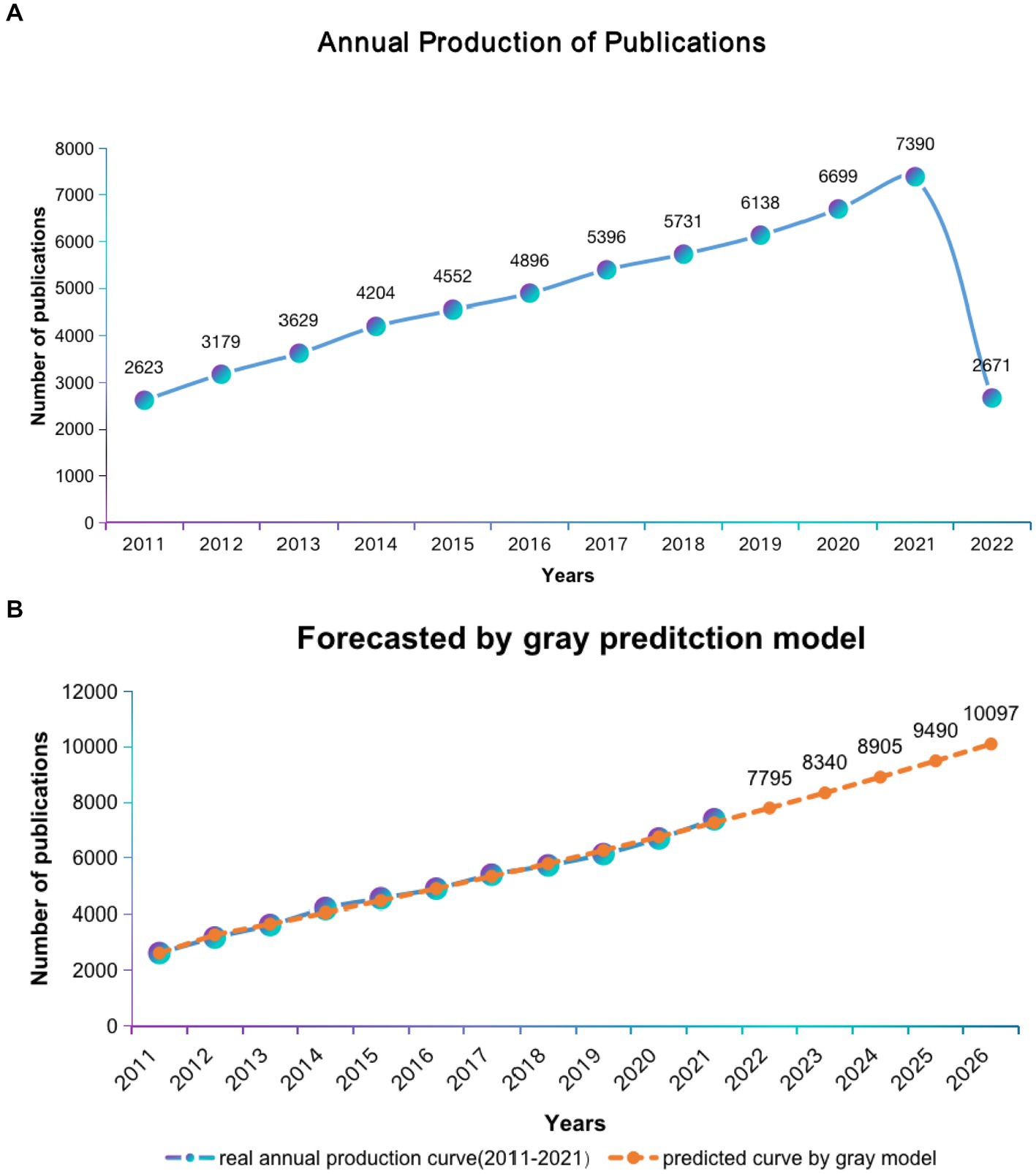
Figure 2. Global trends in publications of ASD research. (A) Single-year publication output over the past decade. (B) Model forecast curves for publication growth trends.
Distribution of countries and institutions
Autism-related research has been conducted by researchers from a variety of countries and institutions, and articles in this field have been cited 1,231,588 times (Tables 1, 2). CiteSpace visualizes collaborative networks between institutions and countries (Figures 3A,B). As shown in the international collaborations network of autism research (Figure 3C), the USA and UK are the leading countries working closely with other countries.
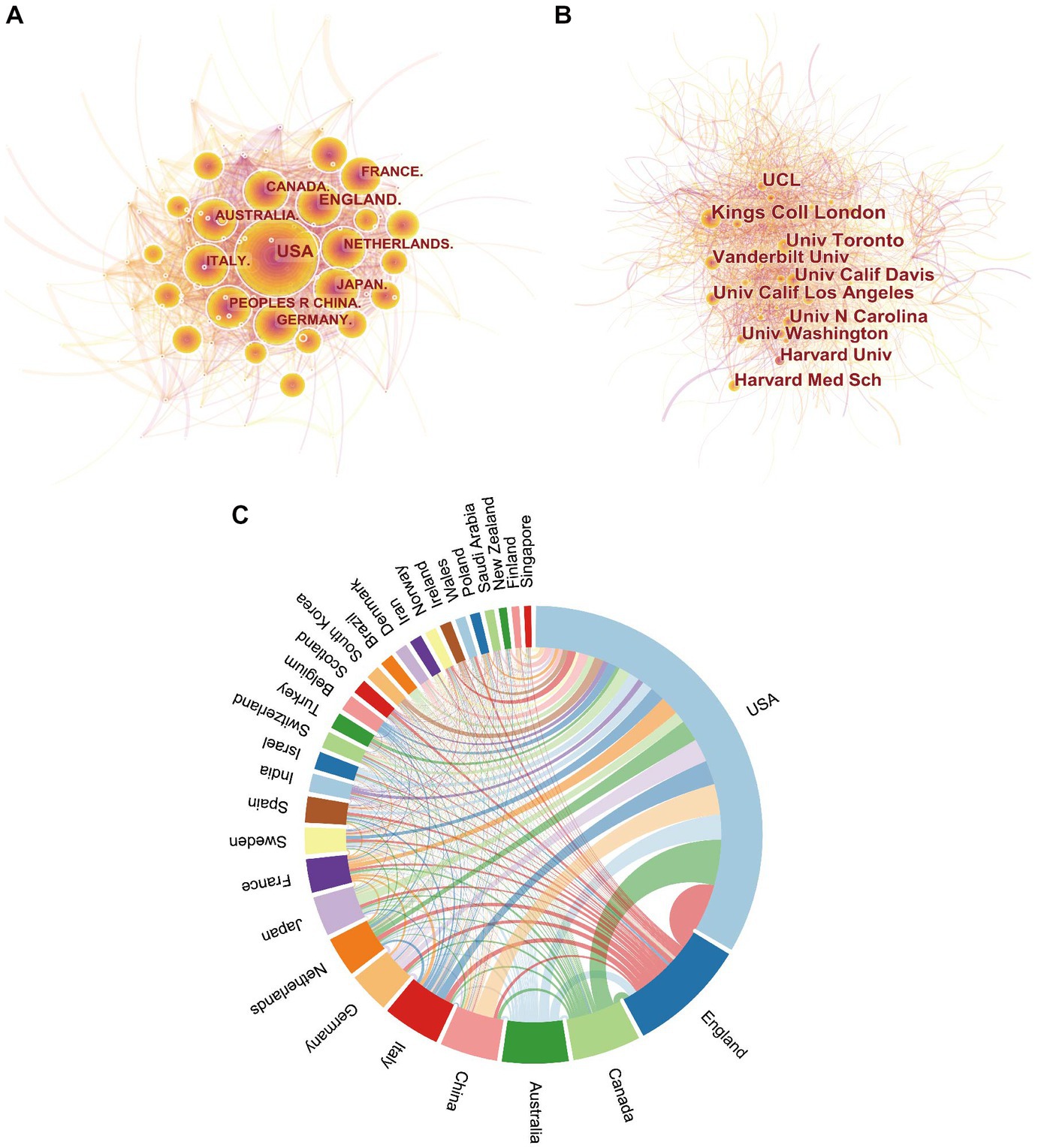
Figure 3. The distribution of countries and institutions. Map of countries (A) and institutions (B) contributed to publications related to ASD research. (C) Network diagram showing international collaborations involved in ASD research. The nodes represent the countries and institutions; the color depth and size of the circle are positively correlated to the number of posts. The thickness of the curved connecting lines represents the strength of collaboration in the countries and institutions.
Analysis of journals
The h-index combines productivity and impact; typically, a high h-index means a high recognition. As presented in Table 3, the Journal of Autism and Developmental Disorders, PLOS One, and Molecular Psychiatry were among the top three of the 20 journals with the highest h-index. The Journal of Autism and Developmental Disorders has the highest number of articles (3478) and cited number of publications (90308). Among the top 20, four journals with impact factors >10 include Molecular Psychiatry (IF: 13.437), Biological Psychiatry (IF: 12.810), Proceedings of the National Academy of Sciences of the United States of America (IF: 12.779), Journal of the American Academy of Child and Adolescent Psychiatry (IF: 13.113), which have been cited more than 10,000 times. In addition, 75% of journals belong to Q1 (Table 3). The cited journals provided the knowledge base of the citing journals. The yellow paths illustrate that studies published in “molecular, biology, immunology” journals tended to cite journals primarily in the domains of “molecular, biology, genetics,” and “psychology, education, social.” The paths colored with grass-green paths illustrate that studies published in “medicine, medical, clinical” journals tended to cite journals primarily in the domains of “molecular, biology, and genetics.” The pale blue paths showcase that research published in “psychology, education, health” journals preferred to quote journals mostly in the domains of “molecular, biology, genetics,” “health, nursing, medicine,” and “psychology, education, social (Figure 4).”
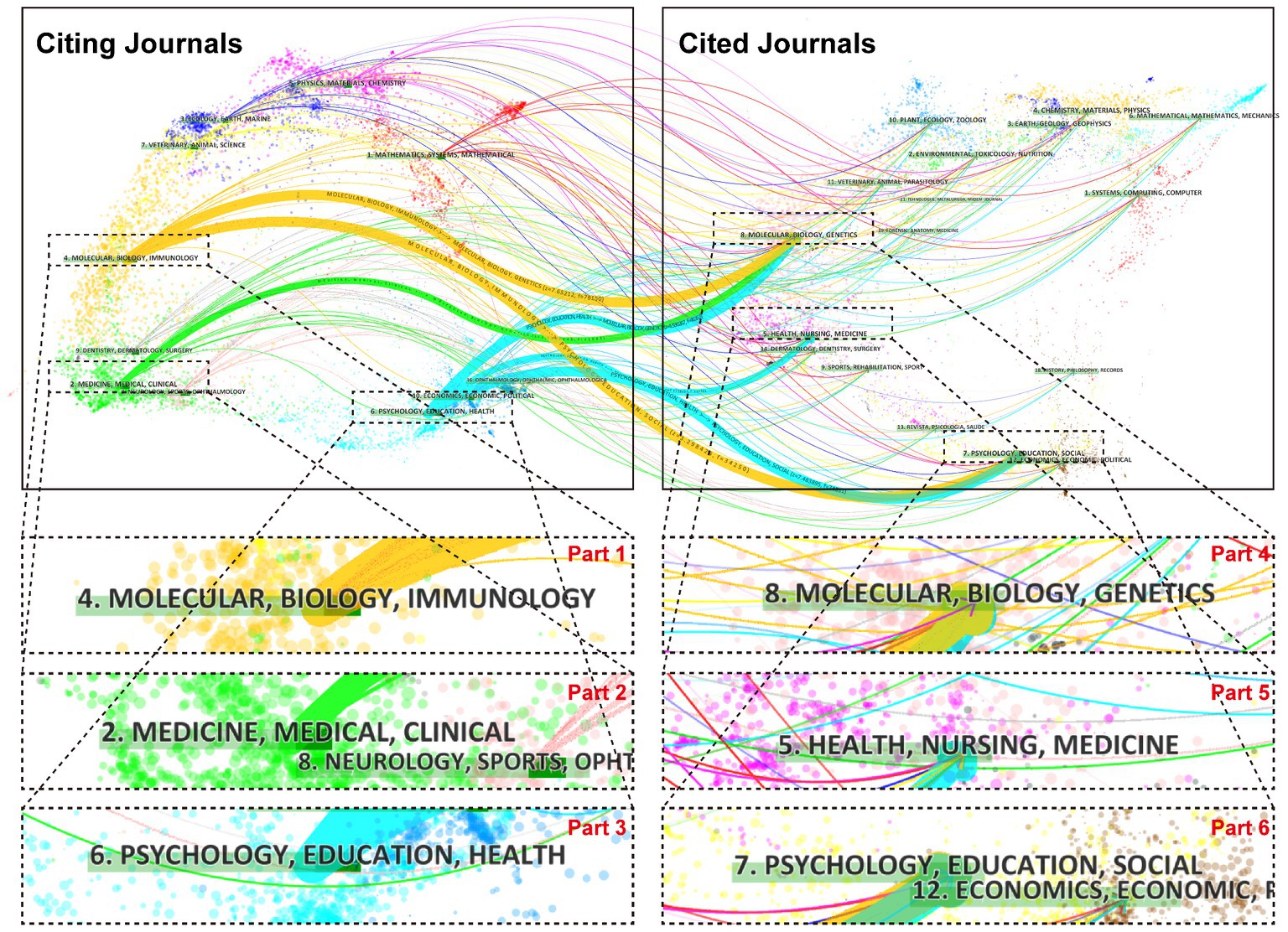
Figure 4. A dual-map overlay of journals that published work related to ASD. A presentation of citation paths at a disciplinary level on a dual-map overlay. The width of the paths is proportional to the z-score-scale citation frequency. The labels on the map represent the research subjects covered by the journals, and the wavy curve connects the citing articles on the left side of the map and the cited articles on the right side of the map.
Analysis of authors
The top 10 most effective authors who have contributed to autism research are listed in Table 4. The g-index and m-index are derivatives of the h-index, and if scientists publish at least 10 articles, of which 7 papers have been cited cumulatively 51 (>49), the g-index is 7; the m-index is related to the academic age of the scientists. The large g-index, h-index, and m-index indicate a great influence on the scholar’s academic influence and high academic achievement. Professor Catherine Lord from the USA is ranked first and has made outstanding contributions to autism research over the past 10 years. In terms of the number of publications, Simon Baron-Cohen was the most productive author (n = 278), followed by Tony Charman (n = 212) and Christopher Gillberg (n = 206). In terms of citations in this field, Daniel H. Geschwind was ranked first (18,127 citations), followed by Catherine Lord (14,830 citations) and Joseph D. Buxbaum (14,528 citations).
Analysis of reference
The co-citation analysis network of 1,056,125 references (Figure 5A) showed that two articles appear simultaneously in the bibliography of the third cited document. The top 20 co-cited references (over the past decade) summarized in ASD studies are listed in Supplementary Table S2. Most of this highly cited literature focuses on the genetic field, discovering genetic risk loci and associated mutations, constructing mutation networks highly associated with autism, and identifying genes associated with autism synaptic destruction. Some studies indicated that de novo mutations in ASD might partially explain the etiology. Multiple studies have revealed genetic variants associated with ASD, such as rare copy number variants (CNVs), de novo likely gene-disrupting (LGD) mutations, missense or nonsense de novo variants, and de novo duplications. In the cluster network graph, different colors represent varied clusters, and each node represents a cited paper, displaying the distribution of topics in the field (Figure 5B). The network is divided into 25 co-citation clusters (Figure 5B), primarily related to the diagnosis, etiology, and intervention of autism. The etiological studies include five clusters, de novo mutation, inflammation, gut microbiota, mitochondrial dysfunction, and mouse model. Intervention literature focuses on early intensive behavioral intervention, intranasal oxytocin, video modeling, and multisensory integration. The diagnostic aspects of ASD include neuroimaging functional connectivity and Diagnostic and Statistical Manual of Mental Disorders (DSM-5). In addition, some of the references focus on gender/sex differences and sleep problems. Coronavirus disease 2019 (COVID-19) is a new cluster for autism research.
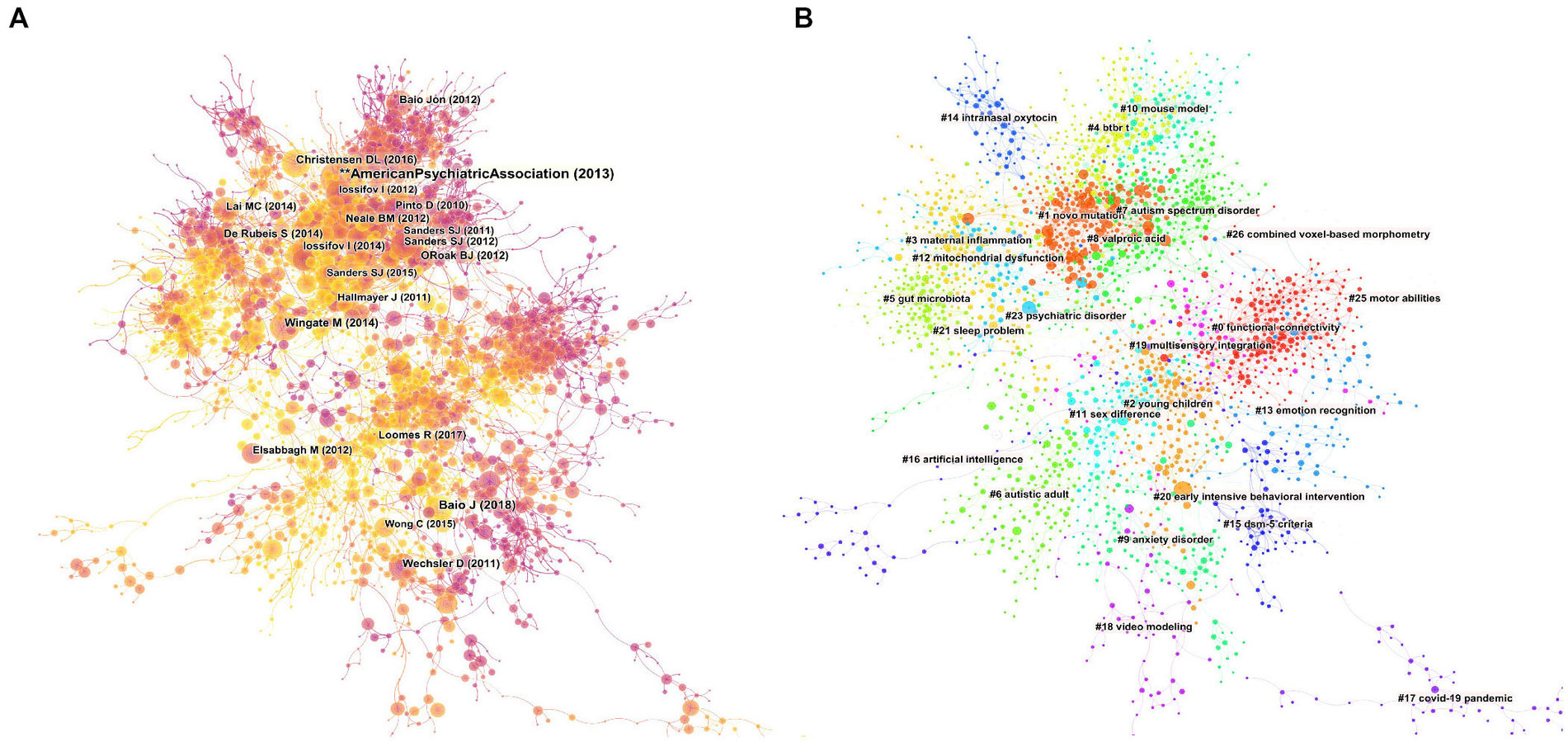
Figure 5. Mapping on co-cited references. (A) A network map showing the co-cited references. (B) Co-cited clusters with cluster labels.
Co-occurrence analysis of keywords
The co-occurrence analysis of keywords in ASD research articles was performed using VOSviewer software; the keywords that occurred ≥200 times were analyzed after being grouped into four clusters of different colors (Figure 6A); the temporal distribution of keywords is summarized in Figure 6B. This map identifies various categories of research: Etiological mechanisms (red), Clinical features (green), Intervention features (blue), and the Asperger cluster (yellow). In the “Etiological mechanisms” cluster, the research includes brain structure and function, genetics, and neuropathology. In the “Clinical features” cluster, the common keywords were “symptoms,” “diagnosis,” “prevalence,” and its comorbidities, including “anxiety” and “sleep.” In the “Intervention features” cluster, the research population of ASD is concentrated in “young children,” “intervention,” and “communication.” These interventions improve the learning and social skills through the involvement of parents and schools.
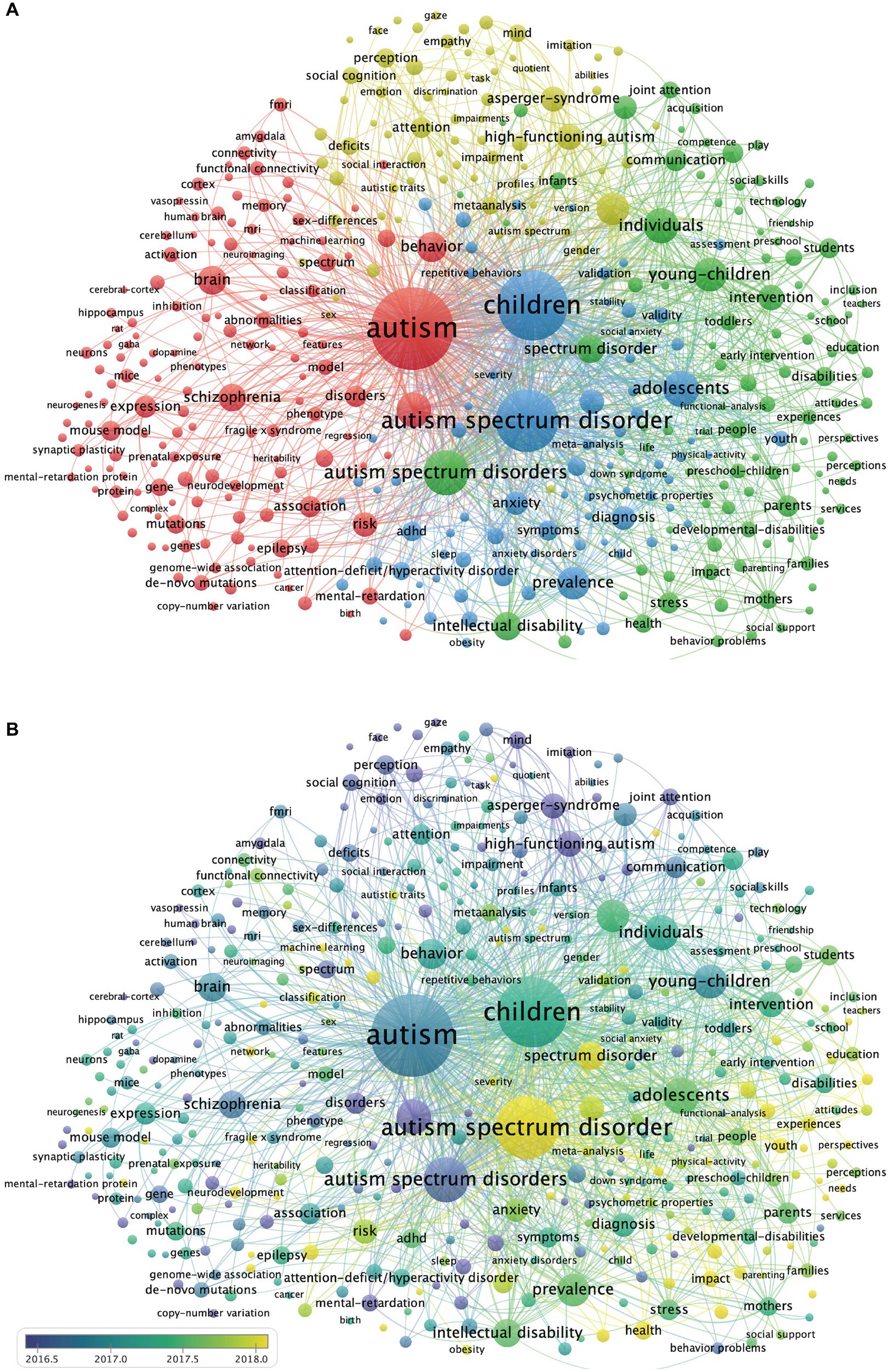
Figure 6. Keywords co-occurrence network. (A) Cluster analysis of keywords. There are four clusters of keywords: red indicates Cluster 1 (n = 145), green indicates Cluster 2 (n = 104), blue indicates Cluster 3 (n = 78), yellow indicates Cluster 4 (n = 80). (B) Evolution of keyword frequency. A minimum number of occurrences of a keyword = 200. Overall, 407 keywords met the threshold criteria. The yellow keywords appear later than purple keywords.
The 100 top-cited publications
The screening of the 100 most cited publications on ASD between 2011 and 2022 by Bibliometrix software package, each with >500 citations. The detailed evaluation index information for countries, institutions, journals, and authors (Supplementary Tables S3–S6).
Taken together, the results indicated that the United States is the country that publishes the most highly cited articles (n = 64), including single-country publications (n = 37) and multiple-country publications (n = 27); most articles are from academic institutions within the USA (Figures 7A,B).
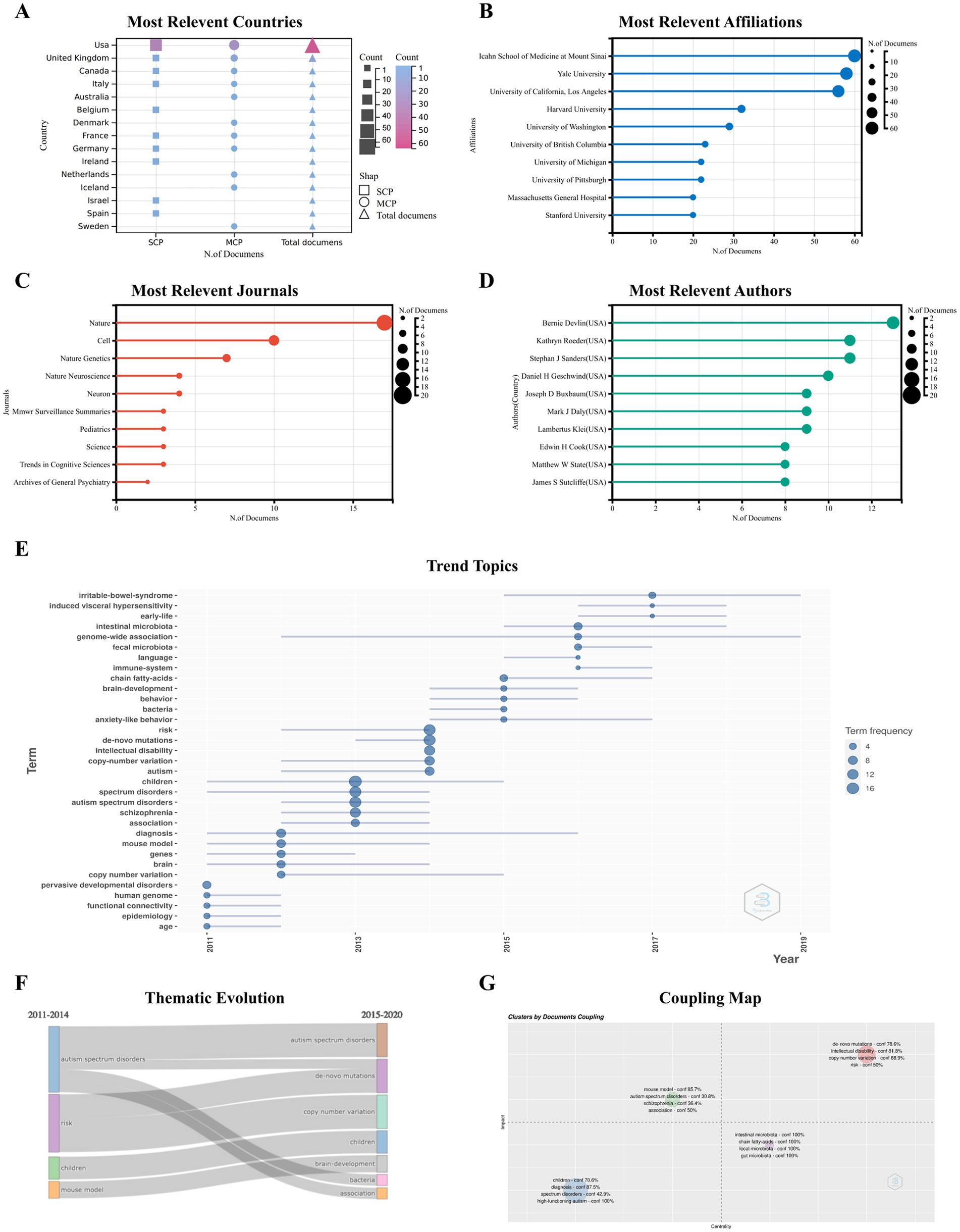
Figure 7. Analysis of the 100 top-cited publications Characteristics of 100 top-cited publications. The most relevant countries (A), affiliations (B), journals (C) and authors (D). Trend topics (E) and thematic evolution (F) of 100 top-cited publication. Coupling Map (G): the coupled analysis of the article, references and keywords is carried out, the centrality of the x-axis is displayed, the y-axis is the impact, and the confidence (conf%) is calculated.
The 100 top-cited ASD publications were published in 48 journals; 17 articles were published in Nature (n = 17), making it the highest h-index journal in this list (Supplementary Table S5). In addition, 10 articles were published in Cell, and 7 articles were published in Nature Genetics (Figure 7C). When considering the individual authors’ academic contributions, Bernie Devlin provided 13 publications, followed by Kathryn Roeder and Stephan J Sanders, with 11 publications each (Figure 7D). The details of the top 10 top-cited papers are summarized in Table 5. An article titled “A general framework for estimating the relative pathogenicity of human genetic variants” published by Martin Kircher in Nature Genetics, received the highest number of citations (n = 3,353).
The 100 top-cited ASD articles encompassed a range of keywords (Figure 7E) and displayed the main cluster of themes through specific periods (2011–2022) by analyzing those in the selected literature. The Sankey diagrams of thematic evolution explain the topics that evolved throughout the years (Figure 7F). In summary, the core topics of the ASD field in 2011–2014 consisted of the risk of childhood ASD and further developed into the field of human genetic variants, such as CNV and de novo mutations. In the subperiod 2015–2020, the further expansion of studies in this field leads to new clusters, such as “immune system,” “brain development,” and “fecal microbiota.” Genome research in the upper right quadrant, including mutations and risk, is a major and evolving theme. The coupled map showing the brain-gut axis field, including intestinal microbiota and chain fatty acids, located in the lower right corner is crucial for autism research but is not yet well-developed (Figure 7G). The research on autism, including animal models, schizophrenia, is a well-developed field, but that on high-functioning autism and diagnosis is a marginal field.
Discussion
This study used various bibliometric tools and software to analyze the published articles on ASD based on the WoSCC database from 2011 to 2022. By 2022, the annual number of publications and citations of ASD-related research showed an overall upward trend, reflecting the sustained interest and the diversity of areas.
General information
In terms of regional distribution, researchers from different countries and regions have participated in autism research, and international cooperation has been relatively close over the past decade. The scientific research is supported by several countries and institutions, as well as by large-scale international cooperation (28, 29). The USA has the highest collaboration performance, especially with UK, Canada, Australia and China. In addition to the limitations of financial aid, ethical, cultural, and racial issues are complex constraints that should be overcome for more diversity in autism research (30, 31). We speculated that further collaboration between institutions and countries could promote autism research.
Among the top 20 academic journals, most of the papers were in the Journal of Autism and Developmental Disorders. The frequent publishing of ASD-related papers indicates the interest of readers and journal editors in Autism. Also, substantial studies have been carried out on ASDs, autism, and molecular autism. These journals are ascribed to the field of ASD, focusing on autism research and communication ASD science. However, the analysis of the 10 most cited publications revealed that they were published in such as Nature, Cell, Lancet; these ASD studies were all from high-impact journals.
From the perspective of authors, some of them have made outstanding contributions to global ASD research. Professor Catherine Lord, the top rank for h-index, m-index analysis conducted by the author, and who developed the two gold standards for autism diagnosis (32, 33), are the most influencing factors in the field. ASD is a disease with complex genetic roots. Dr. Catherine Lord has conducted multiple studies using genome-wide association study (GWAS) and gene set analysis to identify variant signatures in autism (34). A recent meta-analysis showed that 74–93% of ASD risk is heritable, with an analysis of CNVs that highlights the key role of rare and de novo mutations in the etiology of ASD (35). Variation-affected gene clusters on networks associated with synaptic transmission, neuronal development, and chromatin regulation (36, 37). The identification of the cross-disorder genetic risk factors found by assessing SNP heritability in five psychiatric disorders (38). Five of the top 10 cited papers in Table 5 focus on genetic variation, suggesting that over the past decade, research has shifted from a general concept of genetic risk to the different types of genetic variations associated with autism.
Simon Baron-Cohen of the Autism Research Center at the University of Cambridge was the most published author between 2011 and 2021. He contributed to the mind-blindness hypothesis of autism, developed the autism spectrum quotient (AQ) screening tool for autism, and focused on gender differences in autism (39–41). There are gender/sex differences in the volume and tissue density of brain regions, including the amygdala, hippocampus, and insula, and the heart-blind hypothesis links emotional recognition in individuals with autism to deficits in the amygdala (41–43). Then, Simon et al. backed up the “extreme male brain” theory of autism in a study of 36,000 autistic individuals aged 16–89 (44). Recently, an increasing number of studies from different perspectives have focused on how sex/gender differences are related to autism (4, 5, 45). In the future, studies of neural dimorphism in brain development in autism need to be conducted across the lifespan to reduce age-induced biases (41).
Hotspots and Frontiers
Keyword analysis was a major indicator for research trends and hotspot analysis. This study shows that keywords for autism research include etiological mechanism, clinical characteristics, and intervention characteristics. Genetic, environmental, epigenetic, brain structure, neuropathological, and immunological factors have contributed to studying its etiological mechanism (46, 47). The studies on the abnormal cortical development in ASD have reported early brain overgrowth (48), reduced resting cerebral blood flow in the medial PFC and anterior cingulate (49), focal disruption of neuronal migration (50), and transcriptomic alterations in the cerebral cortex of autism (51). Genomics studies have identified several variants and genes that increase susceptibility to autism, affecting biological pathways related to chromatin remodeling, regulation of neuronal function, and synaptic development (51–54). In addition, many autism-related genes are enriched in cortical glutamatergic neurons, and mutations in the genes encoding these proteins result in neuronal excitation-inhibitory balance (51, 55). A recent study using single-cell sequencing of the developing human cerebral cortex found strong cell-type-specific enrichment of noncoding mutations in ASD (56). Interestingly, genes interact with the environment; some studies have shown that environmental exposure during pregnancy is a risk factor for brain development (57), and there are changes in DNA methylation in the brains of ASD patients, reflecting an underlying epigenetic dysregulation.
Presently, the diagnosis of ASD is mainly based on symptoms and behaviors, but the disease has a high clinical heterogeneity, and the individual differences between patients are obvious (58). In this study, the keywords of the intervention cluster show the importance of early individualized intervention. Patient data are multidimensional, and individualized diagnoses could be made at multiple levels, such as age, gender, clinical characteristics, and genetic characteristics (59). Early individual genetic diagnosis aids clinical evaluation, ranging from chromosomal microarray (CMA) to fragile X genetic testing (60). However, the results of genetic research cannot guide the treatment. Notably, the treatment of autism is dominated by educational practices and behavioral interventions (61). Medication may address other co-occurring conditions, such as sleep disturbances, epilepsy, and gastrointestinal dysfunction (9). Professor Catherine Lord pointed out that the future of autism requires coordinated, large-scale research to develop affordable, individualized, staged assessments and interventions for people with ASD (62). Professor Baron-Cohen noted that increasing the sample size and collecting data from the same individual multiple times could reduce heterogeneity (58). In addition, screening for objective and valid biomarkers in the future would help to stratify diagnosis and reduce heterogeneity.
According to the keyword trend analysis of 100 highly cited documents, the genetic risk of autism was determined as the hot focus of research, and immune dysregulation and gut microbiome are the new development frontiers after 2015. Patients with ASD have altered immune function, microglia activation was observed in postmortem brain samples, and increased production of inflammatory cytokines and chemokines was observed in cerebrospinal fluid. The microglia are involved in synaptic pruning, and cytokines also affect neuronal migration and axonal projections (63–65). In addition, abnormal peripheral immune responses during pregnancy might affect the developing brain, increasing likelihood of autism (66). Several studies have pointed to abnormalities in immune-related genes in the brain and peripheral blood of autistic patients (51, 67, 68). Immune dysfunction is involved in the etiology of ASD and mediates the accompanying symptoms of autism. The patients have multiple immune-related diseases, asthma, allergic rhinitis, Crohn’s disease, and gastrointestinal dysfunction (69–71). Children with frequent gastrointestinal symptoms, such as abdominal pain, gas, constipation, or diarrhea, had pronounced social withdrawal and stereotyped behavior (70–72). Several studies suggested that these autism-related gastrointestinal problems might be related to intestinal microbiota composition (72–74). Accumulating evidence suggested that the microbiota-gut-brain axis influences human neurodevelopment, a complex system involving immune, metabolic, and vagal pathways in which bacterial metabolites directly affect the brain by disrupting the gut and blood–brain barrier (75–78). Fecal samples from children with autism contained high Clostridium species and low Bifidobacterium species (79, 80). Probiotics can modulate gut microbiota structure and increase the relative abundance of Bifidobacteria, and clinical studies have shown that supplementation with probiotic strains improves attention problems in children with autism (81, 82). Recent clinical trials have shown that microbiota transfer therapy improves gastrointestinal symptoms and autism-like behaviors in children with ASD (83, 84).
Conclusion
This scientometric study comprehensively analyzes about a decade of global autism research. Research in the field of autism is increasing, with the United States making outstanding contributions, while neuroscience, genetics, brain imaging studies, or studies of the gut microbiome deepen our understanding of the disorder. The study of the brain-gut axis elucidates the mechanism of immunology in autism, and immunological research may be in the renaissance. The current data serve as a valuable resource for studying ASD. However, the future of autism needs further development. In the future, relevant research should be included for a complete representation of the entire autism population, and further collaboration between individuals, institutions, and countries is expected to accelerate the development of autism research.
Data availability statement
The original contributions presented in the study are included in the article/Supplementary material, further inquiries can be directed to the corresponding authors.
Author contributions
MJ, DZ, JL, and LW conceived and designed the study. MJ, TL, XL, KY, and LZ contributed to data collection and data analysis. MJ wrote the original manuscript. DZ, JL, and LW revised the article and contributed to the final version of the manuscript. All authors contributed to the article and approved the submitted version.
Funding
This work was supported by grants from the Key-Area Research and Development Program of Guangdong Province (2019B030335001) and the National Natural Science Foundation of China (grant numbers 82171537, 81971283, 82071541, and 81730037).
Conflict of interest
The authors declare that the research was conducted in the absence of any commercial or financial relationships that could be construed as a potential conflict of interest.
Publisher’s note
All claims expressed in this article are solely those of the authors and do not necessarily represent those of their affiliated organizations, or those of the publisher, the editors and the reviewers. Any product that may be evaluated in this article, or claim that may be made by its manufacturer, is not guaranteed or endorsed by the publisher.
Supplementary material
The Supplementary material for this article can be found online at: https://www.frontiersin.org/articles/10.3389/fpsyt.2023.1096769/full#supplementary-material
References
1. Newschaffer, CJ, Croen, LA, Daniels, J, Giarelli, E, Grether, JK, Levy, SE, et al. The epidemiology of autism spectrum disorders. Annu Rev Public Health. (2007) 28:235–58. doi: 10.1146/annurev.publhealth.28.021406.144007
2. Christensen, DL, Braun, KVN, Baio, J, Bilder, D, Charles, J, Constantino, JN, et al. Prevalence and characteristics of autism spectrum disorder among children aged 8 years - autism and developmental disabilities monitoring network, 11 sites, United States, 2012. MMWR Surveill Summ. (2018) 65:1–23. doi: 10.15585/mmwr.ss6513a1
3. Maenner, MJ, Shaw, KA, Bakian, AV, Bilder, DA, Durkin, MS, Esler, A, et al. Prevalence and characteristics of autism spectrum disorder among children aged 8 years - autism and developmental disabilities monitoring network, 11 sites, United States, 2018. MMWR Surveill Summ. (2021) 70:1–16. doi: 10.15585/mmwr.ss7011a1
4. Green, RM, Travers, AM, Howe, Y, and McDougle, CJ. Women and autism Spectrum disorder: diagnosis and implications for treatment of adolescents and adults. Curr Psychiatry Rep. (2019) 21:22. doi: 10.1007/s11920-019-1006-3
5. Huang, Y, Arnold, SR, Foley, KR, and Trollor, JN. Diagnosis of autism in adulthood: a scoping review. Autism. (2020) 24:1311–27. doi: 10.1177/1362361320903128
6. Loomes, R, Hull, L, and Mandy, WPL. What is the male-to-female ratio in autism spectrum disorder? A systematic review and meta-analysis. J Am Acad Child Adolesc Psychiatry. (2017) 56:466–74. doi: 10.1016/j.jaac.2017.03.013
7. Geschwind, DH. Genetics of autism spectrum disorders. Trends Cogn Sci. (2011) 15:409–16. doi: 10.1016/j.tics.2011.07.003
8. Landa, R, and Garrett-Mayer, E. Development in infants with autism spectrum disorders: a prospective study. J Child Psychol Psychiatry. (2006) 47:629–38. doi: 10.1111/j.1469-7610.2006.01531.x
9. Hyman, SL, Levy, SE, and Myers, SM. Council on children with disabilities SOD, behavioral P. identification, evaluation, and management of children with autism spectrum disorder. Pediatrics. (2020) 145:e20193447. doi: 10.1542/peds.2019-3447
10. Lord, C, Elsabbagh, M, Baird, G, and Veenstra-Vanderweele, J. Autism Spectrum disorder. Lancet. (2018) 392:508–20. doi: 10.1016/S0140-6736(18)31129-2
11. Zwaigenbaum, L, and Penner, M. Autism spectrum disorder: advances in diagnosis and evaluation. BMJ. (2018) 361:k1674. doi: 10.1136/bmj.k1674
12. Bottema-Beutel, K, Kapp, SK, Lester, JN, Sasson, NJ, and Hand, BN. Avoiding ableist language: suggestions for autism researchers. Autism Adulthood. (2021) 3:18–29. doi: 10.1089/aut.2020.0014
13. Simonoff, E, Pickles, A, Charman, T, Chandler, S, Loucas, T, and Baird, G. Psychiatric disorders in children with autism spectrum disorders: prevalence, comorbidity, and associated factors in a population-derived sample. J Am Acad Child Adolesc Psychiatry. (2008) 47:921–9. doi: 10.1097/CHI.0b013e318179964f
14. Cooper, ID. Bibliometrics basics. J Med Libr Assoc. (2015) 103:217–8. doi: 10.3163/1536-5050.103.4.013
15. Chen, C, and Song, M. Visualizing a field of research: a methodology of systematic scientometric reviews. PLoS One. (2019) 14:e0223994. doi: 10.1371/journal.pone.0223994
16. Carmona-Serrano, N, Moreno-Guerrero, AJ, Marin-Marin, JA, and Lopez-Belmonte, J. Evolution of the autism literature and the influence of parents: a scientific mapping in web of science. Brain Sci. (2021) 11:74. doi: 10.3390/brainsci11010074
17. Rong, P, Fu, Q, Zhang, X, Liu, H, Zhao, S, Song, X, et al. A bibliometrics analysis and visualization of autism spectrum disorder. Front Psychol. (2022) 13:884600. doi: 10.3389/fpsyt.2022.884600
18. Wang, K, Duan, W, Duan, Y, Yu, Y, Chen, X, Xu, Y, et al. A bibliometric insight of genetic factors in Asd: emerging trends and new developments. Brain Sci. (2020) 11:33. doi: 10.3390/brainsci11010033
19. Wang, YX, Arora, R, Choi, Y, Chung, HW, Egorov, VI, Frahm, J, et al. Implications of web of science journal impact factor for scientific output evaluation in 16 institutions and investigators’ opinion. Quant Imaging Med Surg. (2014) 4:453–61. doi: 10.3978/j.issn.2223-4292.2014.11.16
20. Luo, X, Duan, H, and He, L. A novel riccati equation grey model and its application in forecasting clean energy. Energy. (2020) 205:118085. doi: 10.1016/j.energy.2020.118085
21. Yan, J, Li, Y, and Zhou, P. Impact of Covid-19 pandemic on the epidemiology of stds in China: based on the Gm (1,1) model. BMC Infect Dis. (2022) 22:519. doi: 10.1186/s12879-022-07496-y
22. Ahmad, T. Global research trends in Mers-Cov: a comprehensive bibliometric analysis from 2012 to 2021. Front Public Health. (2022) 10:933333. doi: 10.3389/fpubh.2022.933333
23. Hirsch, JE. An index to quantify an individual’s scientific research output. Proc Natl Acad Sci U S A. (2005) 102:16569–72. doi: 10.1073/pnas.0507655102
24. Eyre-Walker, A, and Stoletzki, N. The assessment of science: the relative merits of post-publication review, the impact factor, and the number of citations. PLoS Biol. (2013) 11:e1001675. doi: 10.1371/journal.pbio.1001675
25. van Eck, NJ, and Waltman, L. Software survey: Vosviewer, a computer program for bibliometric mapping. Scientometrics. (2010) 84:523–38. doi: 10.1007/s11192-009-0146-3
26. Chen, C. Searching for intellectual turning points: progressive knowledge domain visualization. Proc Natl Acad Sci U S A. (2004) 101:5303–10. doi: 10.1073/pnas.0307513100
27. Xu, X, and Feng, C. Mapping the knowledge domain of the evolution of emergy theory: a bibliometric approach. Environ Sci Pollut Res Int. (2021) 28:43114–42. doi: 10.1007/s11356-021-14959-3
28. Flotte, TR. The science policy implications of a trump presidency. Hum Gene Ther. (2017) 28:1–2. doi: 10.1089/hum.2016.29037.trf
29. Gostin, LO. Government and science: the unitary executive versus freedom of scientific inquiry. Hast Cent Rep. (2009) 39:11–2. doi: 10.1353/hcr.0.0114
30. Butrous, G. International cooperation to promote advances in medicine. Ann Thorac Med. (2008) 3:79–81. doi: 10.4103/1817-1737.41913
31. Watson, R. Developing countries need stronger ethical guidelines on research. BMJ. (2007) 334:1076. doi: 10.1136/bmj.39220.615127.DB
32. Luyster, R, Gotham, K, Guthrie, W, Coffing, M, Petrak, R, Pierce, K, et al. The autism diagnostic observation schedule-toddler module: a new module of a standardized diagnostic measure for autism spectrum disorders. J Autism Dev Disord. (2009) 39:1305–20. doi: 10.1007/s10803-009-0746-z
33. Zheng, S, Kaat, A, Farmer, C, Kanne, S, Georgiades, S, Lord, C, et al. Extracting latent subdimensions of social communication: a cross-measure factor analysis. J Am Acad Child Adolesc Psychiatry. (2021) 60:768–782.e6. doi: 10.1016/j.jaac.2020.08.444
34. Autism Spectrum Disorders Working Group of The Psychiatric Genomics C. Meta-analysis of Gwas of over 16,000 individuals with autism spectrum disorder highlights a novel locus at 10q24.32 and a significant overlap with schizophrenia. Mol Autism. (2017) 8:21. doi: 10.1186/s13229-017-0137-9
35. Tick, B, Bolton, P, Happe, F, Rutter, M, and Rijsdijk, F. Heritability of autism spectrum disorders: a meta-analysis of twin studies. J Child Psychol Psychiatry. (2016) 57:585–95. Epub 2015/12/29. doi: 10.1111/jcpp.12499
36. Sanders, SJ, He, X, Willsey, AJ, Ercan-Sencicek, AG, Samocha, KE, Cicek, AE, et al. Insights into autism Spectrum disorder genomic architecture and biology from 71 risk loci. Neuron. (2015) 87:1215–33. doi: 10.1016/j.neuron.2015.09.016
37. Pinto, D, Delaby, E, Merico, D, Barbosa, M, Merikangas, A, Klei, L, et al. Convergence of genes and cellular pathways dysregulated in autism spectrum disorders. Am J Hum Genet. (2014) 94:677–94. doi: 10.1016/j.ajhg.2014.03.018
38. Cross-Disorder Group of the Psychiatric Genomics C Lee, SH, Ripke, S, Neale, BM, Faraone, SV, Purcell, SM, et al. Genetic relationship between five psychiatric disorders estimated from genome-wide Snps. Nat Genet. (2013) 45:984–94. doi: 10.1038/ng.2711
39. Baron-Cohen, S, Wheelwright, S, Skinner, R, Martin, J, and Clubley, E. The autism-spectrum quotient (Aq): evidence from asperger syndrome/high-functioning autism, males and females, scientists and mathematicians. J Autism Dev Disord. (2001) 31:5–17. doi: 10.1023/a:1005653411471
40. Grove, R, Baillie, A, Allison, C, Baron-Cohen, S, and Hoekstra, RA. The latent structure of cognitive and emotional empathy in individuals with autism, first-degree relatives and typical individuals. Mol Autism. (2014) 5:42. doi: 10.1186/2040-2392-5-42
41. Lai, MC, Lerch, JP, Floris, DL, Ruigrok, AN, Pohl, A, Lombardo, MV, et al. Imaging sex/gender and autism in the brain: etiological implications. J Neurosci Res. (2017) 95:380–97. doi: 10.1002/jnr.23948
42. Ruigrok, AN, Salimi-Khorshidi, G, Lai, MC, Baron-Cohen, S, Lombardo, MV, Tait, RJ, et al. A meta-analysis of sex differences in human brain structure. Neurosci Biobehav Rev. (2014) 39:34–50. doi: 10.1016/j.neubiorev.2013.12.004
43. Baron-Cohen, S, Ring, HA, Bullmore, ET, Wheelwright, S, Ashwin, C, and Williams, SC. The amygdala theory of autism. Neurosci Biobehav Rev. (2000) 24:355–64. doi: 10.1016/s0149-7634(00)00011-7
44. Greenberg, DM, Warrier, V, Allison, C, and Baron-Cohen, S. Testing the empathizing-systemizing theory of sex differences and the extreme male brain theory of autism in half a million people. Proc Natl Acad Sci U S A. (2018) 115:12152–7. doi: 10.1073/pnas.1811032115
45. Baron-Cohen, S, Cassidy, S, Auyeung, B, Allison, C, Achoukhi, M, Robertson, S, et al. Attenuation of typical sex differences in 800 adults with autism Vs. 3,900 controls. PLoS One. (2014) 9:e102251. doi: 10.1371/journal.pone.0102251
46. Neuhaus, E, Beauchaine, TP, and Bernier, R. Neurobiological correlates of social functioning in autism. Clin Psychol Rev. (2010) 30:733–48. doi: 10.1016/j.cpr.2010.05.007
47. Young, AM, Chakrabarti, B, Roberts, D, Lai, MC, Suckling, J, and Baron-Cohen, S. From molecules to neural morphology: understanding neuroinflammation in autism spectrum condition. Mol Autism. (2016) 7:9. doi: 10.1186/s13229-016-0068-x
48. Courchesne, E, Campbell, K, and Solso, S. Brain growth across the life span in autism: age-specific changes in anatomical pathology. Brain Res. (2011) 1380:138–45. doi: 10.1016/j.brainres.2010.09.101
49. Ohnishi, T, Matsuda, H, Hashimoto, T, Kunihiro, T, Nishikawa, M, Uema, T, et al. Abnormal regional cerebral blood flow in childhood autism. Brain. (2000) 123:1838–44. doi: 10.1093/brain/123.9.1838
50. Wegiel, J, Kuchna, I, Nowicki, K, Imaki, H, Wegiel, J, Marchi, E, et al. The neuropathology of autism: defects of neurogenesis and neuronal migration, and dysplastic changes. Acta Neuropathol. (2010) 119:755–70. doi: 10.1007/s00401-010-0655-4
51. Voineagu, I, Wang, X, Johnston, P, Lowe, JK, Tian, Y, Horvath, S, et al. Transcriptomic analysis of autistic brain reveals convergent molecular pathology. Nature. (2011) 474:380–4. doi: 10.1038/nature10110
52. Bernier, R, Golzio, C, Xiong, B, Stessman, HA, Coe, BP, Penn, O, et al. Disruptive Chd8 mutations define a subtype of autism early in development. Cells. (2014) 158:263–76. doi: 10.1016/j.cell.2014.06.017
53. Krumm, N, Turner, TN, Baker, C, Vives, L, Mohajeri, K, Witherspoon, K, et al. Excess of rare, inherited truncating mutations in autism. Nat Genet. (2015) 47:582–8. doi: 10.1038/ng.3303
54. Gilman, SR, Iossifov, I, Levy, D, Ronemus, M, Wigler, M, and Vitkup, D. Rare De novo variants associated with autism implicate a large functional network of genes involved in formation and function of synapses. Neuron. (2011) 70:898–907. doi: 10.1016/j.neuron.2011.05.021
55. Naaijen, J, Bralten, J, Poelmans, G, consortium I, Glennon, JC, Franke, B, et al. Glutamatergic and gabaergic gene sets in attention-deficit/hyperactivity disorder: association to overlapping traits in Adhd and autism. Transl Psychiatry. (2017) 7:e999. doi: 10.1038/tp.2016.273
56. Trevino, AE, Muller, F, Andersen, J, Sundaram, L, Kathiria, A, Shcherbina, A, et al. Chromatin and gene-regulatory dynamics of the developing human cerebral cortex at single-cell resolution. Cells. (2021) 184:5053–5069.e23. doi: 10.1016/j.cell.2021.07.039
57. Guinchat, V, Thorsen, P, Laurent, C, Cans, C, Bodeau, N, and Cohen, D. Pre-, Peri- and neonatal risk factors for autism. Acta Obstet Gynecol Scand. (2012) 91:287–300. doi: 10.1111/j.1600-0412.2011.01325.x
58. Lombardo, MV, Lai, MC, and Baron-Cohen, S. Big data approaches to decomposing heterogeneity across the autism spectrum. Mol Psychiatry. (2019) 24:1435–50. doi: 10.1038/s41380-018-0321-0
59. Mottron, L. A radical change in our autism research strategy is needed: back to prototypes. Autism Res. (2021) 14:2213–20. doi: 10.1002/aur.2494
60. Jeste, SS, and Geschwind, DH. Disentangling the heterogeneity of autism spectrum disorder through genetic findings. Nat Rev Neurol. (2014) 10:74–81. doi: 10.1038/nrneurol.2013.278
61. Reichow, B, Hume, K, Barton, EE, and Boyd, BA. Early intensive behavioral intervention (Eibi) for young children with autism spectrum disorders (Asd). Cochrane Database Syst Rev. (2018) 5:CD009260. doi: 10.1002/14651858.CD009260.pub3
62. Lord, C, Charman, T, Havdahl, A, Carbone, P, Anagnostou, E, Boyd, B, et al. The lancet commission on the future of care and clinical research in autism. Lancet. (2022) 399:271–334. doi: 10.1016/S0140-6736(21)01541-5
63. Vargas, DL, Nascimbene, C, Krishnan, C, Zimmerman, AW, and Pardo, CA. Neuroglial activation and neuroinflammation in the brain of patients with autism. Ann Neurol. (2005) 57:67–81. doi: 10.1002/ana.20315
64. Bessis, A, Bechade, C, Bernard, D, and Roumier, A. Microglial control of neuronal death and synaptic properties. Glia. (2007) 55:233–8. doi: 10.1002/glia.20459
65. Onore, C, Careaga, M, and Ashwood, P. The role of immune dysfunction in the pathophysiology of autism. Brain Behav Immun. (2012) 26:383–92. doi: 10.1016/j.bbi.2011.08.007
66. Patterson, PH. Immune involvement in schizophrenia and autism: etiology, pathology and animal models. Behav Brain Res. (2009) 204:313–21. doi: 10.1016/j.bbr.2008.12.016
67. Filosi, M, Kam-Thong, T, Essioux, L, Muglia, P, Trabetti, E, Spooren, W, et al. Transcriptome signatures from discordant sibling pairs reveal changes in peripheral blood immune cell composition in autism spectrum disorder. Transl Psychiatry. (2020) 10:106. doi: 10.1038/s41398-020-0778-x
68. Glatt, SJ, Tsuang, MT, Winn, M, Chandler, SD, Collins, M, Lopez, L, et al. Blood-based gene expression signatures of infants and toddlers with autism. J Am Acad Child Adolesc Psychiatry. (2012) 51:934–944.e2. doi: 10.1016/j.jaac.2012.07.007
69. Kohane, IS, McMurry, A, Weber, G, MacFadden, D, Rappaport, L, Kunkel, L, et al. The co-morbidity burden of children and Young adults with autism spectrum disorders. PLoS One. (2012) 7:e33224. doi: 10.1371/journal.pone.0033224
70. Needham, BD, Adame, MD, Serena, G, Rose, DR, Preston, GM, Conrad, MC, et al. Plasma and fecal metabolite profiles in autism spectrum disorder. Biol Psychiatry. (2021) 89:451–62. doi: 10.1016/j.biopsych.2020.09.025
71. Robinson-Agramonte, MLA, Noris Garcia, E, Fraga Guerra, J, Vega Hurtado, Y, Antonucci, N, Semprun-Hernandez, N, et al. Immune dysregulation in autism spectrum disorder: what do we know about it? Int J Mol Sci. (2022) 23:3033. doi: 10.3390/ijms23063033
72. Chaidez, V, Hansen, RL, and Hertz-Picciotto, I. Gastrointestinal problems in children with autism, developmental delays or typical development. J Autism Dev Disord. (2014) 44:1117–27. doi: 10.1007/s10803-013-1973-x
73. Strati, F, Cavalieri, D, Albanese, D, De Felice, C, Donati, C, Hayek, J, et al. New evidences on the altered gut microbiota in autism spectrum disorders. Microbiome. (2017) 5:24. doi: 10.1186/s40168-017-0242-1
74. Hsiao, EY, McBride, SW, Hsien, S, Sharon, G, Hyde, ER, McCue, T, et al. Microbiota modulate behavioral and physiological abnormalities associated with neurodevelopmental disorders. Cells. (2013) 155:1451–63. doi: 10.1016/j.cell.2013.11.024
75. Cryan, JF, O’Riordan, KJ, Cowan, CSM, Sandhu, KV, Bastiaanssen, TFS, Boehme, M, et al. The microbiota-gut-brain Axis. Physiol Rev. (2019) 99:1877–2013. doi: 10.1152/physrev.00018.2018
76. Dinan, TG, and Cryan, JF. Gut instincts: microbiota as a key regulator of brain development, ageing and neurodegeneration. J Physiol. (2017) 595:489–503. doi: 10.1113/JP273106
77. Fiorentino, M, Sapone, A, Senger, S, Camhi, SS, Kadzielski, SM, Buie, TM, et al. Blood-brain barrier and intestinal epithelial barrier alterations in autism spectrum disorders. Mol Autism. (2016) 7:49. doi: 10.1186/s13229-016-0110-z
78. Srikantha, P, and Mohajeri, MH. The possible role of the microbiota-gut-brain-Axis in autism Spectrum disorder. Int J Mol Sci. (2019) 20:2115. doi: 10.3390/ijms20092115
79. De Angelis, M, Piccolo, M, Vannini, L, Siragusa, S, De Giacomo, A, Serrazzanetti, DI, et al. Fecal microbiota and metabolome of children with autism and pervasive developmental disorder not otherwise specified. PLoS One. (2013) 8:e76993. doi: 10.1371/journal.pone.0076993
80. Finegold, SM, Dowd, SE, Gontcharova, V, Liu, C, Henley, KE, Wolcott, RD, et al. Pyrosequencing study of fecal microflora of autistic and control children. Anaerobe. (2010) 16:444–53. doi: 10.1016/j.anaerobe.2010.06.008
81. Duque, A, Demarqui, FM, Santoni, MM, Zanelli, CF, Adorno, MAT, Milenkovic, D, et al. Effect of probiotic, prebiotic, and synbiotic on the gut microbiota of autistic children using an in vitro gut microbiome model. Food Res Int. (2021) 149:110657. doi: 10.1016/j.foodres.2021.110657
82. Grimaldi, R, Cela, D, Swann, JR, Vulevic, J, Gibson, GR, Tzortzis, G, et al. In vitro fermentation of B-Gos: impact on Faecal bacterial populations and metabolic activity in autistic and non-autistic children. FEMS Microbiol Ecol. (2017) 93:fiw233. doi: 10.1093/femsec/fiw233
83. Kang, DW, Adams, JB, Gregory, AC, Borody, T, Chittick, L, Fasano, A, et al. Microbiota transfer therapy alters gut ecosystem and improves gastrointestinal and autism symptoms: an open-label study. Microbiome. (2017) 5:10. doi: 10.1186/s40168-016-0225-7
Keywords: autism spectrum disorder, bibliometric study, CiteSpace, VOSviewer, research frontiers
Citation: Jiang M, Lu T, Yang K, Li X, Zhao L, Zhang D, Li J and Wang L (2023) Autism spectrum disorder research: knowledge mapping of progress and focus between 2011 and 2022. Front. Psychiatry. 14:1096769. doi: 10.3389/fpsyt.2023.1096769
Edited by:
Lawrence Fung, Stanford University, United StatesReviewed by:
George Fragulis, University of Western Macedonia, GreeceIrina Jarvers, University of Regensburg, Germany
Copyright © 2023 Jiang, Lu, Yang, Li, Zhao, Zhang, Li and Wang. This is an open-access article distributed under the terms of the Creative Commons Attribution License (CC BY). The use, distribution or reproduction in other forums is permitted, provided the original author(s) and the copyright owner(s) are credited and that the original publication in this journal is cited, in accordance with accepted academic practice. No use, distribution or reproduction is permitted which does not comply with these terms.
*Correspondence: Jun Li, anVubGkxOTg1QGJqbXUuZWR1LmNu; Lifang Wang, bGlmYW5nd2FuZ0Biam11LmVkdS5jbg==
 Miaomiao Jiang
Miaomiao Jiang Tianlan Lu1
Tianlan Lu1 Jun Li
Jun Li Lifang Wang
Lifang Wang